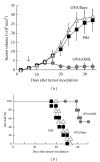Oligomannose-coated liposome as a novel adjuvant for the induction of cellular immune responses to control disease status
- PMID: 24224170
- PMCID: PMC3810488
- DOI: 10.1155/2013/562924
Oligomannose-coated liposome as a novel adjuvant for the induction of cellular immune responses to control disease status
Abstract
Professional phagocytic cells, such as dendritic cells, are mainly responsible for phagocytosis, antigen presentation, and cytokine secretion, which induce subsequent activation of T cell-mediated immunity. Thus, strategies that deliver antigens and stimulatory signals to the cells have significant implications for vaccine design. In this paper, we summarize the potential for liposomes coated with the neoglycolipids containing oligomannose residues (OMLs) as a novel adjuvant for induction of Th1 immune responses and CTLs specific for the encased antigen. OMLs preferentially take up peripheral phagocytic cells. In response to OML uptake, the cells secrete IL-12 selectively, enhance the expression of costimulatory molecules, and migrate into lymphoid tissues from peripheral tissues. OMLs also have the ability to deliver encapsulated protein antigens to the MHC class I and class II pathways to generate antigen-specific CTLs and Th1 cells, respectively, and lipid antigen to CD1d to activate NKT cells. Since administration of OML-based vaccines can eliminate an established tumor, inhibit elevation of the serum IgE level, and prevent progression of protozoan infections in several murine, human, and bovine models, OML-based vaccines have revealed their potential for clinical use in vaccination for a variety of diseases in which CTLs and/or Th1 cells act as effector cells.
Figures




Similar articles
-
Importance of particle size of oligomannose-coated liposomes for induction of Th1 immunity.Int Immunopharmacol. 2021 Oct;99:108068. doi: 10.1016/j.intimp.2021.108068. Epub 2021 Aug 17. Int Immunopharmacol. 2021. PMID: 34426114
-
In vitro uptake of oligomannose-coated liposomes leads to differentiation of inflammatory monocytes into mature antigen-presenting cells that can activate T cells.Int Immunopharmacol. 2018 Apr;57:102-111. doi: 10.1016/j.intimp.2018.02.013. Epub 2018 Feb 22. Int Immunopharmacol. 2018. PMID: 29477971
-
Requirement of TLR4 signaling for the induction of a Th1 immune response elicited by oligomannose-coated liposomes.Immunol Lett. 2016 Oct;178:61-7. doi: 10.1016/j.imlet.2016.07.016. Epub 2016 Jul 30. Immunol Lett. 2016. PMID: 27485186
-
Adjuvants Enhancing Cross-Presentation by Dendritic Cells: The Key to More Effective Vaccines?Front Immunol. 2018 Dec 13;9:2874. doi: 10.3389/fimmu.2018.02874. eCollection 2018. Front Immunol. 2018. PMID: 30619259 Free PMC article. Review.
-
Towards a new generation of vaccines: the cytokine IL-12 as an adjuvant to enhance cellular immune responses to pathogens during prime-booster vaccination regimens.Histol Histopathol. 2001 Apr;16(2):655-67. doi: 10.14670/HH-16.655. Histol Histopathol. 2001. PMID: 11332721 Review.
Cited by
-
Chemical Reactive Anchoring Lipids with Different Performance for Cell Surface Re-engineering Application.ACS Omega. 2018 Feb 28;3(2):1589-1599. doi: 10.1021/acsomega.7b01886. Epub 2018 Feb 7. ACS Omega. 2018. PMID: 29503972 Free PMC article.
-
Development of Mannose-Modified Carboxylated Curdlan-Coated Liposomes for Antigen Presenting Cell Targeted Antigen Delivery.Pharmaceutics. 2020 Aug 11;12(8):754. doi: 10.3390/pharmaceutics12080754. Pharmaceutics. 2020. PMID: 32796567 Free PMC article.
-
Plasmodium berghei circumsporozoite protein encapsulated in oligomannose-coated liposomes confers protection against sporozoite infection in mice.Malar J. 2014 Nov 5;13:426. doi: 10.1186/1475-2875-13-426. Malar J. 2014. PMID: 25373617 Free PMC article.
-
Effective Respiratory CD8 T-Cell Immunity to Influenza Virus Induced by Intranasal Carbomer-Lecithin-Adjuvanted Non-replicating Vaccines.PLoS Pathog. 2016 Dec 20;12(12):e1006064. doi: 10.1371/journal.ppat.1006064. eCollection 2016 Dec. PLoS Pathog. 2016. PMID: 27997610 Free PMC article.
-
Nanoparticle cancer vaccines: Design considerations and recent advances.Asian J Pharm Sci. 2020 Sep;15(5):576-590. doi: 10.1016/j.ajps.2019.10.006. Epub 2019 Dec 31. Asian J Pharm Sci. 2020. PMID: 33193861 Free PMC article. Review.
References
-
- Palucka K, Banchereau J. Dendritic cells: a link between innate and adaptive immunity. Journal of Clinical Immunology. 1999;19(1):12–25. - PubMed
-
- Banchereau J, Steinman RM. Dendritic cells and the control of immunity. Nature. 1998;392(6673):245–252. - PubMed
-
- Tacken PJ, Torensma R, Figdor CG. Targeting antigens to dendritic cells in vivo. Immunobiology. 2006;211(6-8):599–608. - PubMed
Publication types
MeSH terms
Substances
LinkOut - more resources
Full Text Sources
Other Literature Sources
Research Materials

